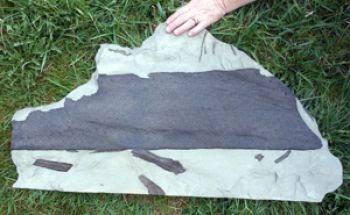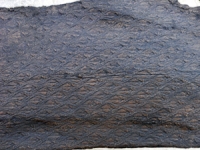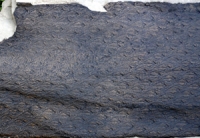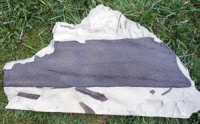
Lepidodendrons belong to one of the earliest major plant groups, the clubmosses. They were one of the major species living in the Carboniferous Period coal-forest swamps. Because of the diamond-shaped leaf scar patterns in their bark they were also known as a scale-tree. Other isolated parts of the plant are given other names. Lepidostrobus (or strobili) are the spore-containing cones which are found at the ends of the branches. The root sections are known as Stigmaria. Lepidodendron started life as a short, fat stump, which grew rapidly upward, with its pole-like trunk hardly increasing in circumference. It has been estimated that they could reach heights exceeding 165ft after only two or three years. Upon reaching its maximum height, simple forking branches sprouted out from its crown. The youngest parts of the tree, regardless of whether it is the growing trunks or the final uppermost branches, had long, slim often dagger-like leaves which looked similar to large blades of grass (called Sigillaria). A very rapid life cycle, in conditions with plentiful water, warmth and nutrients explains why Lepidodendron and other plants of the time managed to produce such a large quantity of biomass that is found in today's coal deposits.
Calamites (Annularia, Asterophylites)- meaning reed (also known as giant horsetail), was another of the giants which inhabited the warm damp swamps and marshes that covered the land during the Carboniferous Period. They reached heights of up to 100ft. Can you imagine this fast growing plant reaching a height greater than a ten-story building? Today's surviving species, Equisetum (horsetail), grows to a height of little more than three feet with a diameter of about 1/8th inch. Calamites (horsetails) are characterized by a stiff central stem or trunk with regular intervals of whorls of upswept leaves (similar to inverted umbrellas). They are further characterized by fine vertical ribbing between the transverse bands which showed the old whorl leaf segments. They were very successful worldwide, especially along riverbanks, where their bases were frequently buried by shifting sands as they continued to grow. This ability to adapt to its changing environment helped it to support the plant, preventing it from falling over during times of local flooding. Calamites formed spore cones at the end of the growing tip. Spores released from these cones was one of the methods of reproduction used by Calamites along with an underground system of runner-like rhizomes that produced new plants asexually (similar to today's mint plants).
The main fossil on this plate is Lepidodendron with small sections of Calamites to the far left and right, just off of center and at the very bottom of the specimen below. There is also a longer, narrow section along the upper left side of the Lepidodendron trunk. Parts of several Sigillaria leaves are also found on the plate.
polyresin
33.25 x 17.75 x 1.125 inches
Item 2236
Category: Replicas
Type: Wall Plaques
Phylum: Plants
Class: Ferns
MORE PHOTOS:




Now Over 1,000 Items!
PrehistoricStore.com offers the largest selection of replica fossils and other fossil-related products anywhere in the world!
Download a Full Catalog (3MB PDF)
OVER 260 PAGES OF REPLICAS AND MORE!
